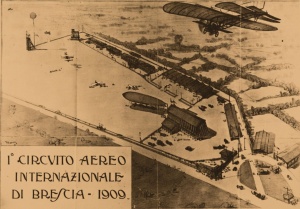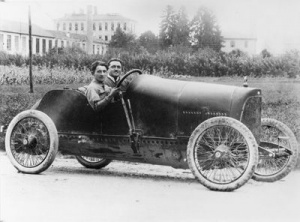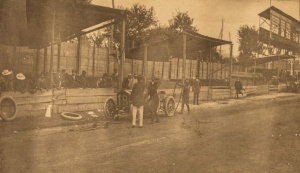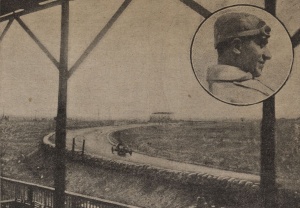The circuit
History
Starting from Brescia for Mantua and crossing Castenedolo, the road then gently descends on the low embankment between beautiful countryside until you find, on the right, the Osteria della Fascia d’oro: here begins the moor of Montichiari. The Monteclarense moor, arid, gravelly and devoid of trees, became the ideal reference point for motor racing, in which the young car industry tried its hand, seeing in them the possibility of its expansion and Montichiari, hosting such events on its territory, saw grow its prestige and its economy. In September 1899 there were four days dedicated to motoring in Brescia with the execution of a race. The races continued in the following years and in September 1905 there were also the Vincenzo Florio Cup, the Conte di Salemi Cup and the Italian Cup, all three won by G.B.Raggio with a 100 hp Itala. The finish line and the stands were located right at the Gold Band of Montichiari. The Florio Cup was also run in 1907 with the victory of Minoia over Isotta Freschini. In 1920 it was decided to create a permanent racetrack. The first Italian Grand Prix was held on 4 September 1921. A path was chosen entirely enclosed in the territory of Montichiari, obtaining a track of 18 km.
The circuit
History
Partendo da Brescia per Mantova ed attraversando Castenedolo, la strada poi scende dolcemente sul basso terrapieno fra una bella campagna finché non si trova, a destra, l’Osteria della Fascia d’oro: qui comincia la brughiera di Montichiari. La brughiera Monteclarense, arida ghiaiosa e priva di alberi, divenne il punto di riferimento ideale per le corse automobilistiche, nelle quali la giovane industria automobilistica si cimentava, vedendo in esse la possibilità del suo espandersi e Montichiari, ospitando tali manifestazioni sul suo territorio, vedeva crescere il suo prestigio e la sua economia. Nel settembre del 1899 si ebbero in Brescia quattro giornate dedicate all’automobilismo con l’effettuazione di una corsa. Le corse continuarono negli anni successivi e nel settembre del 1905 si corsero anche la Coppa Vincenzo Florio, la Coppa Conte di Salemi e la Coppa d’Italia, vinte tutte e tre da G.B.Raggio con una Itala di 100 hp. Il traguardo e le tribune erano poste proprio alla Fascia d’Oro di Montichiari. La Coppa Florio si corse anche nel 1907 con la vittoria di Minoia su Isotta Freschini. Nel 1920 si decise di creare un autodromo permanente. Il 4 settembre 1921 si disputò il primo Gran Premio d’Italia. Fu scelto un percorso tutto racchiuso nel territorio di Montichiari, ottenendo una pista di 18 km.
History of
Montichiari
The Montichiari area was inhabited since the year 1000, when the territory was ruled by the powerful Longhi family, feudal lords of the county.
The name of Montichiari, whose etymology is somewhat uncertain, has undergone several transformations over the centuries: from Montisclaris (XII century). to Monteclaro (XIII century) and Montechiaro (XVI century). In 1862 “sul Chiese” was added to the name Montechiaro and in 1877 it became the current Montichiari.
After the battle of Maclodio ( October the 1st), the country swore loyalty to the Republic of Venice, to which Montichiari remained loyal until its decline in 1797, despite all the military events that alternated over the years.
Around the year 1805, the protagonist was undoubtedly Napoleon I, great ruler who involved the habitants of Montechiari in his military operations, placing the army in the moors. In 1848, under the hands of some patriots, including Angelo Mazzoldi- literary from Montichiari, the population rose up against the Austrians.
Montichiari subsequently had an very important role during the battles of San Martino and Solferino: in 1859in fact the military strategy of the battle was defined and the rearguards of the Piedmontese and French armies were organized. Several public and private buildings – including the Parish church and the new hospital – were taken over to afford this intense action.
History of
Montichiari
The Montichiari area was inhabited since the year 1000, when the territory was ruled by the powerful Longhi family, feudal lords of the county.
The name of Montichiari, whose etymology is somewhat uncertain, has undergone several transformations over the centuries: from Montisclaris (XII century). to Monteclaro (XIII century) and Montechiaro (XVI century). In 1862 “sul Chiese” was added to the name Montechiaro and in 1877 it became the current Montichiari.
After the battle of Maclodio ( October the 1st), the country swore loyalty to the Republic of Venice, to which Montichiari remained loyal until its decline in 1797, despite all the military events that alternated over the years.
Around the year 1805, the protagonist was undoubtedly Napoleon I, great ruler who involved the habitants of Montechiari in his military operations, placing the army in the moors. In 1848, under the hands of some patriots, including Angelo Mazzoldi- literary from Montichiari, the population rose up against the Austrians.
Montichiari subsequently had an very important role during the battles of San Martino and Solferino: in 1859in fact the military strategy of the battle was defined and the rearguards of the Piedmontese and French armies were organized. Several public and private buildings – including the Parish church and the new hospital – were taken over to afford this intense action.
The
Parabolic Curve
The route chosen for the Circuit had a triangular shape with its apex in the area of Fascia d'Oro where the main attraction of the whole work was created, represented by the link connecting the Ghedi Montichiari municipal road: the parabolic curve, which developed a length of 544.60 meters and was one of the first in the world.
The curve was carried out by backfilling of a height of one meter and ten, with ribs arranged in a mesh that allowed to contain the ballast. The drivers of the time declared that all the other circuits, including the Indianapolis one, could not hold a candle to that of Brescia Montichiari.






























